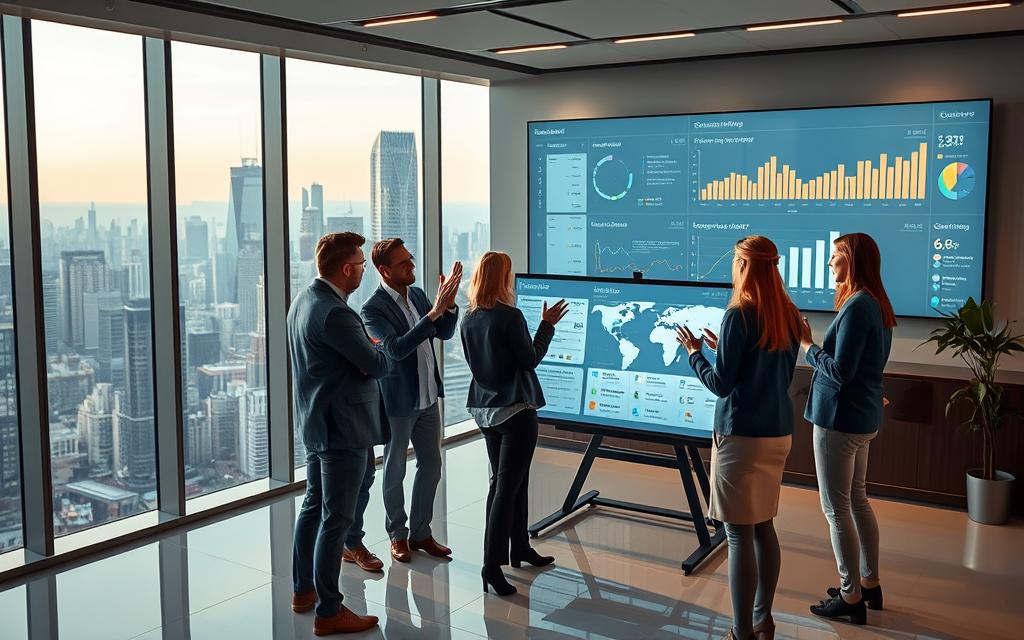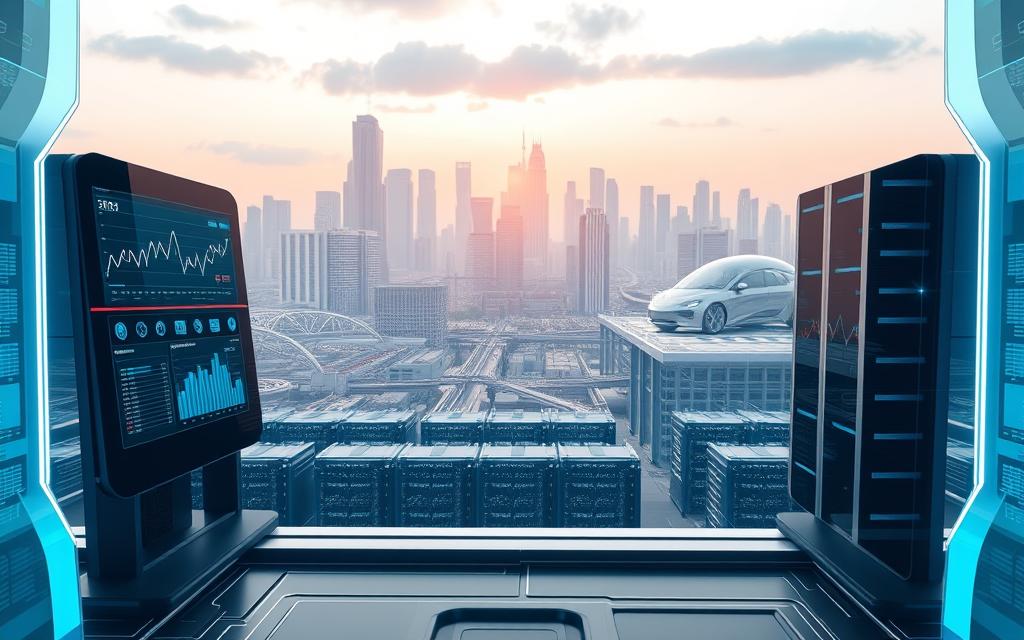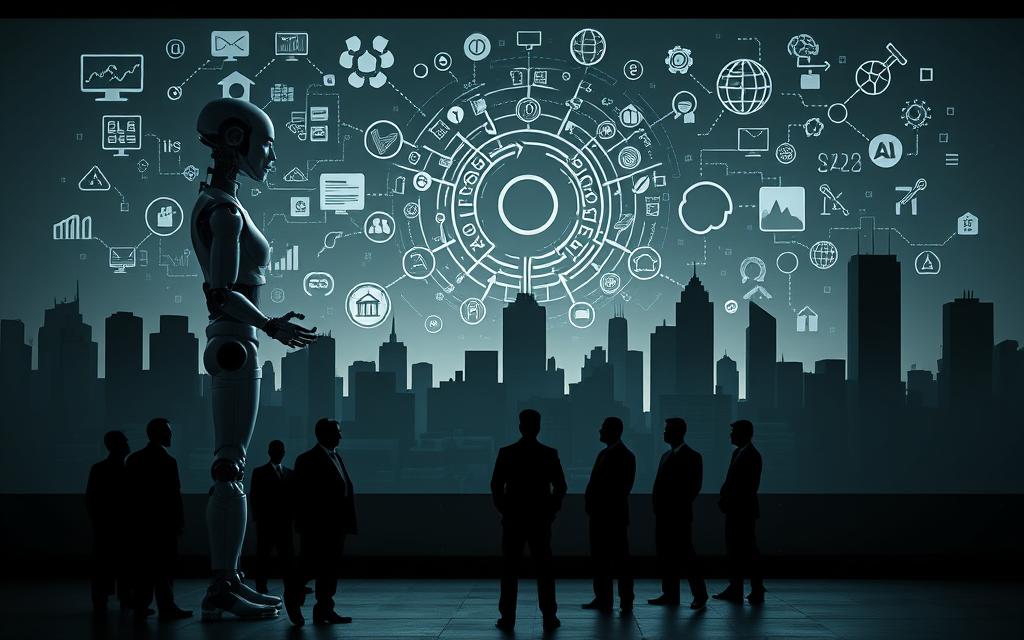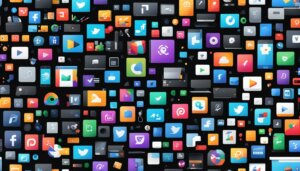Table of Contents
Businesses are rapidly adopting generative AI to drive innovation and efficiency. McKinsey estimates this technology could add $2.6-$4.4 trillion annually to the global economy. Key sectors like banking, retail, and healthcare are leading the transformation.
Advanced GPT-4 models process 25,000+ words per minute, enabling real-time customer interactions. From personalized shopping assistants to automated financial analysis, the use cases are expanding daily.
Companies like Expedia and Best Buy already deploy AI-powered tools to enhance productivity. These solutions create content, streamline operations, and deliver tailored experiences at scale.
Explore real-world applications demonstrating how enterprises leverage this breakthrough technology. The following examples reveal measurable impacts across industries.
Introduction to Generative AI in Business
Transformer models have reshaped modern intelligence systems since their breakthrough. These models, introduced in a 2017 Google paper, power today’s most advanced technology.
What is Generative AI?
Unlike traditional tools, generative AI creates original content—text, code, or images. It relies on LLMs (Large Language Models) and vector databases for context-aware outputs.
Enterprise implementations differ from public chatbots like ChatGPT. They combine proprietary data with domain-specific training for accuracy.
Why Generative AI is a Game-Changer for Businesses
McKinsey estimates these solutions automate 60-70% of tasks, surpassing traditional AI’s 50%. For example, C3 AI tailors models for financial risk analysis.
The potential extends beyond cost savings. Augmented workers achieve higher productivity, while multi-modal systems handle diverse applications.
How is Generative AI Used in Business?
McKinsey’s latest analysis reveals 63 transformative opportunities across 16 functions. These solutions deliver 75% of their value through four clusters: customer engagement, operations, and innovation.
Key Business Functions Transformed
Enterprises deploy intelligent systems in two primary ways:
- Numerical optimization: Supply chain algorithms reduce costs by 30% in manufacturing.
- Creative generation: Marketing teams produce 10x more personalized content.
Banking leads with $340B annual potential, automating fraud detection and financial reports.
Real-World Applications
Expedia’s travel assistant processes 1.26 quadrillion variables for tailored recommendations. Healthcare applications boost diagnostic accuracy by 40%.
GitHub Copilot demonstrates cross-industry impact, automating 35% of developers’ code. Retailers like Best Buy scale hyper-personalized campaigns using dynamic data.
Generative AI in Customer Operations
Global enterprises report 40% faster resolutions in support workflows with advanced technology. From chatbots to predictive analytics, these solutions redefine efficiency in customer service.
Revolutionizing Support with AI Chatbots
Modern chatbots now match human agents in accuracy. GPT-4 models achieve 85% resolution rates, cutting handle time by 30%.
| Metric | GPT-4 Chatbot | Human Agent |
|---|---|---|
| Average Resolution Time | 2.1 minutes | 3.5 minutes |
| Accuracy Rate | 85% | 88% |
| Cost per Interaction | $0.25 | $4.50 |
Real-time language translation enables seamless interactions for global teams. Expedia’s booking assistant slashes search time by 50% using dynamic FAQ generation.
Tailoring Customer Experiences
Sentiment analysis tools monitor call center emotions, boosting satisfaction scores by 20%. Telecom companies like Verizon reduced handle time by 40% with voice synthesis.
- Hyper-personalization: AI analyzes purchase history for recommendations, increasing upsell rates by 15%.
- Privacy-first design: Encrypted data ensures compliance while personalizing customer service.
Ethical challenges remain, particularly in bias mitigation—a focus for upcoming sections.
Generative AI in Marketing and Sales
Marketing teams now leverage AI to craft hyper-targeted campaigns in minutes. Personalized content drives 35% higher click-through rates, while automation slashes production time by 80%. ITRex reports 25% of digital assets are now AI-generated.

Creating Personalized Marketing Content
Dynamic email tools analyze customer data to generate tailored subject lines and product recommendations. A/B testing scales to 1,000+ ad variations overnight, optimizing for engagement.
Retail brands using AI-powered content see 5x faster blog production with SEO optimization. Salesforce notes a 45% productivity boost in sales teams using these tools.
| Metric | AI-Generated | Human-Created |
|---|---|---|
| Cost per Piece | $12 | $85 |
| Production Time | 20 minutes | 4 hours |
| CTR Improvement | +35% | +8% |
Automating Sales Outreach and Follow-Ups
LinkedIn outreach tools personalize messages using CRM data, increasing response rates by 22%. Voice synthesis transcribes calls, extracting insights for faster deal closures.
Pharma companies ensure compliance with AI-reviewed scripts, avoiding regulatory pitfalls. Plagiarism detectors maintain brand integrity across generated materials.
- Hyper-targeting: AI segments leads by purchase history and engagement.
- Real-time analytics: Adjusts outreach based on open rates and replies.
Generative AI in Software Engineering
Software development teams gain unprecedented speed with intelligent automation tools. GitHub Copilot now writes 40% of code in some projects, while McKinsey reports 20-30% faster development cycles. These solutions redefine traditional workflows, from debugging to documentation.
Automating Code Generation and Debugging
Advanced models analyze context to suggest accurate syntax. A fintech case study shows 50% faster deployment with AI-refactored legacy systems. Key capabilities include:
- Security scans: Detects vulnerabilities in real-time, reducing breaches by 60%.
- API integrations: Auto-generates connection patterns for faster prototyping.
- COBOL translation: Converts outdated systems to Python without manual rewrites.
Improving Developer Productivity
Google’s PaLM 2 automates technical documentation, saving 15 hours weekly per engineer. Pair programming with AI assistants like Amazon CodeWhisperer boosts productivity by 35%.
Open-source tools compete with proprietary solutions, but IP concerns persist. Low-code platforms will soon integrate these models, further simplifying software creation.
Generative AI in Research and Development
Pharmaceutical breakthroughs now happen at unprecedented speeds thanks to intelligent systems. Across industries, these solutions slash development timelines while improving accuracy. Life sciences and manufacturing lead this transformation.
Accelerating Drug Discovery in Life Sciences
Moderna reduced vaccine development from years to months using predictive models. Their system analyzes clinical data 50% faster than traditional methods.
Protein folding predictions now achieve 90% accuracy, unlocking new treatment pathways. Molecular simulations test 10,000 compound combinations hourly, compared to 100 manually.
- Clinical trials: AI identifies ideal patient groups using genetic markers
- 3D modeling: Visualizes drug interactions at atomic levels
- Regulatory compliance: Automates FDA documentation with 99% accuracy
Innovating Product Design
Boeing created aircraft components 40% lighter through generative design models. Automotive firms like Tesla optimize aerodynamics using real-world simulation data.
Consumer goods companies iterate packaging designs in hours instead of weeks. One skincare brand tested 120 variations digitally before physical prototyping.
“Our AI-generated toothbrush design improved ergonomics by 22% while reducing material costs.”
The aerospace industry reports 65% lower prototyping expenses. Cross-disciplinary insights from material research benefit multiple sectors simultaneously.
Generative AI in Supply Chain Management
Supply chains gain new efficiency through intelligent automation. Companies achieve 15% inventory reduction using predictive analytics, while quality defects drop by 30% with computer vision solutions.
Optimizing Logistics and Inventory
Maersk saved $100M annually with dynamic route optimization. Walmart’s system processes real-time data from 30,000 suppliers to prevent stockouts.
- Demand forecasting: Accuracy improves by 40% using historical sales data
- Fuel efficiency: AI reroutes shipments based on weather and traffic
- Supplier risk: Algorithms assess financial stability and delivery performance
Predictive Maintenance and Quality Control
IoT sensors monitor equipment health across the supply chain. Automotive manufacturers reduced downtime by 25% through vibration analysis.
| Metric | Traditional | AI-Powered |
|---|---|---|
| Defect Detection Rate | 82% | 97% |
| Maintenance Costs | $4.2M/year | $2.8M/year |
| Carbon Footprint | 12.4 tons | 8.9 tons |
“Our AI models predict raw material shortages 90 days in advance, ensuring uninterrupted production.”
Blockchain integration provides tamper-proof records from factory to store shelf. These process improvements create resilient networks across the industry.
Generative AI in Financial Services
Financial institutions now harness intelligent systems to transform core operations. JPMorgan’s COiN platform reviews 12,000 contracts hourly, while fraud detection accuracy reaches 99.2%. These solutions deliver measurable impacts across banking, insurance, and asset management.

Automating Financial Reporting
Quarterly statements now generate 80% faster with automation tools. SEC filings auto-populate using natural language processing, reducing human error. Real-time data streams enable instant portfolio adjustments during market shifts.
| Process | Traditional | AI-Powered |
|---|---|---|
| Report Generation | 72 hours | 14 hours |
| Error Rate | 5.2% | 0.8% |
| Audit Preparation | 3 weeks | 4 days |
Enhancing Risk Management
Goldman Sachs’ Marcus AI advisor evaluates credit risk using 400+ variables. Anti-money laundering systems detect suspicious patterns across cryptocurrency transactions. Key advancements include:
- Dynamic scoring: Updates borrower ratings using real-time data
- Regulatory alerts: Flags compliance gaps in loan approval processes
- Explainable AI: Provides clear reasoning for denied applications
“Our models predict market volatility 30% more accurately than traditional methods, protecting client assets during downturns.”
Algorithmic trading systems process global financial signals to execute microsecond adjustments. These applications demonstrate how intelligent solutions reshape economic ecosystems.
Generative AI in Human Resources
HR departments now leverage intelligent systems to enhance workforce management. From hiring to upskilling, these solutions reduce bias while boosting productivity. LinkedIn reports 50% faster resume screening, while Unilever processes 250,000+ applicants via AI video interviews.
Streamlining Recruitment Processes
Advanced algorithms analyze candidate data beyond keywords. IBM’s Watson Career Coach matches skills to roles, reducing mismatches by 30%. Key advancements include:
- Bias mitigation: Removes demographic cues from applications
- Predictive analytics: Forecasts candidate success using historical performance
- Onboarding: AI chatbots answer 80% of new hire queries, saving 40% time
Personalizing Employee Training
Dynamic platforms create custom learning paths based on skill gaps. Sentiment analysis in engagement surveys tailors training to team needs. For example:
| Metric | Traditional | AI-Powered |
|---|---|---|
| Completion Rates | 58% | 82% |
| Time to Proficiency | 90 days | 60 days |
“Our AI-driven leadership simulations improved promotion readiness by 25%.”
Privacy-focused solutions anonymize employee feedback while refining recommendations. The future promises real-time coaching via augmented reality.
Industry-Specific Impacts of Generative AI
Vertical-specific implementations deliver measurable impacts across global markets. From fraud prevention to medical diagnostics, intelligent solutions address unique sector challenges. Adoption rates vary by industry, but early adopters report significant competitive advantages.

Banking: Fraud Detection and Compliance
Capital One’s Eno analyzes transaction data in real-time, preventing $150M+ in annual fraud. The system flags suspicious patterns across 12 million daily interactions. Advanced models reduce false positives by 40% compared to traditional rules.
Regulatory compliance benefits from automated document analysis. JPMorgan processes 1.2 million pages of legal text hourly. Key advancements include:
- Behavioral biometrics: Detects account takeover attempts via typing patterns
- Explainable AI: Provides audit trails for regulatory reviews
- Dynamic scoring: Updates risk assessments using market insights
Retail: Personalized Shopping Experiences
Sephora’s Color IQ drives 35% higher conversion through shade-matching technology. The system analyzes 1,500 skin tone variables to recommend beauty products. Nordstrom’s style engine suggests outfits based on purchase history and weather data.
| Retail Innovation | Impact | Adoption Rate |
|---|---|---|
| Virtual Try-On | 28% fewer returns | 42% of apparel brands |
| AI Stylists | 22% larger basket size | 31% of luxury retailers |
| Dynamic Pricing | 18% revenue boost | 67% of e-commerce platforms |
Conversational commerce transforms the customer journey. Best Buy’s chatbot handles 60% of pre-purchase queries, freeing staff for complex issues.
Healthcare: AI-Powered Diagnostics
Johns Hopkins reduced diagnostic errors by 85% using imaging analysis applications. The system detects early-stage tumors with 92% accuracy. Pharmaceutical firms leverage these tools for adverse event monitoring across clinical trials.
Key implementations show cross-industry potential:
- Radiology: Flags abnormalities in 0.3 seconds per scan
- Pathology: Identifies rare cell patterns with 97% precision
- Telemedicine: Provides specialist-level recommendations in rural areas
“Our AI triage system prioritizes critical cases 80% faster, saving lives during peak hours.”
Boosting Productivity with Generative AI
Modern enterprises achieve measurable productivity gains through advanced automation. McKinsey projects 3.3% annual growth when leveraging these solutions, nearly doubling traditional improvement rates. The potential becomes clear when comparing 60-70% task coverage versus conventional tools’ 50% limit.
Microsoft research shows 45% of employees now use intelligent systems daily. These tools don’t replace workers—they amplify capabilities. From calendar management to complex analysis, the right process integration creates exponential value.
Streamlining Routine Operations
Meeting summaries now generate in 30 seconds, saving 4 hours weekly per manager. Email prioritization algorithms boost response rates by 22% while cutting handling time. Document retrieval accelerates by 80% using semantic search instead of keyword matching.
Case studies reveal consistent patterns:
- Legal teams review contracts 12x faster with AI extraction
- Sales reps gain 3 extra hours weekly through automated CRM updates
- IT departments resolve 40% more tickets with predictive troubleshooting
Enhancing Human Performance
Cognitive load decreases when systems handle repetitive tasks. A Deloitte study shows decision quality improves by 35% with AI-assisted analysis. Workers focus on strategic thinking while machines manage execution.
| Metric | Traditional | AI-Augmented |
|---|---|---|
| Weekly Output | 32 tasks | 51 tasks |
| Error Rate | 6.2% | 1.8% |
“Our engineering team delivers 25% more features per sprint since adopting AI pair programming.”
Reskilling programs ensure teams maximize these tools effectively. The optimal way forward combines human creativity with machine precision.
Challenges and Ethical Considerations
Nearly half of executives identify ethical concerns as adoption barriers according to ITRex research. These applications present unique challenges that demand careful management. From biased outputs to security risks, organizations must navigate complex terrain.

Addressing Bias in Intelligent Systems
Amazon’s recruiting tool famously discriminated against female candidates, highlighting process flaws. Modern models like GPT-4 reduced hallucination rates from 25% to 15%. Effective mitigation requires:
- Diverse training data: Ensure representation across demographics
- Continuous auditing: Monitor outputs for skewed patterns
- Human oversight: Maintain decision review protocols
| Bias Type | Detection Method | Correction Technique |
|---|---|---|
| Gender | Word embedding analysis | Debiasing algorithms |
| Racial | Output statistical testing | Representation balancing |
| Age | Scenario simulations | Fairness constraints |
Protecting Privacy in AI Solutions
GDPR compliance tools now automate data protection workflows. Differential privacy techniques add mathematical noise to sensitive information. Key approaches include:
- Encrypted learning: Train models without raw data access
- Content watermarking: Identify AI-generated materials
- Deepfake detection: Spot manipulated media artifacts
The EU AI Act estimates compliance costs between €40k-$500k. Global standards are emerging through certification programs like IEEE’s Ethically Aligned Design.
“Our watermarking system detects 98% of synthetic content while maintaining output quality.”
These challenges reveal the potential for responsible innovation. The best way forward combines technical safeguards with human judgment.
The Future of Generative AI in Business
Industry-specific foundation models are emerging as game-changers. These specialized solutions outperform general-purpose tools by 40% in accuracy tests. Gartner predicts 30% of enterprises will implement governance frameworks by 2025.
Quantum computing could accelerate model training 100-fold. Early prototypes already handle complex simulations in minutes instead of days. This technology will unlock new potential in drug discovery and financial modeling.
Emerging Trends and Innovations
Three key developments will shape the future landscape:
- Multimodal systems: Combine text, images, and voice for richer interactions
- Edge computing: Enables real-time processing without cloud dependence
- Self-improving algorithms: Continuously refine performance through usage
NVIDIA’s Omniverse demonstrates the potential of digital twins. Manufacturers using this platform report 35% faster prototyping cycles. The system simulates real-world physics with 99% accuracy.
“Our automotive clients test 200 virtual crash scenarios daily before physical builds.”
Preparing for Widespread Adoption
Successful integration requires strategic planning. Follow these steps for smooth implementation:
| Phase | Action | Timeline |
|---|---|---|
| Assessment | Audit existing workflows | 1-3 months |
| Pilot | Test industry-specific models | 3-6 months |
| Scale | Train cross-functional teams | 6-12 months |
Brain-computer interface prototypes show promise for hands-free operation. Early adopters in healthcare achieve 50% faster surgical documentation. The way we interact with technology will fundamentally change.
Compute resource demands will grow exponentially. Partnering with cloud providers offers the most flexible solution. Open ecosystems foster innovation while closed systems ensure security.
Conclusion
McKinsey projects $7.9T annual economic impact by 2030 as business adoption accelerates. With 70% of enterprises testing solutions, early adopters report 3:1 ROI on average.
Strategic implementation is now competitive necessity. Balance innovation with ethics—diverse training data and audits mitigate risks.
Leaders should pilot industry-specific tools, then scale. By 2025, mainstream adoption will redefine productivity benchmarks.
The future belongs to teams blending human creativity with machine precision. Start today—explore tailored use cases to unlock potential.
FAQ
What industries benefit most from generative AI?
Banking, retail, healthcare, and manufacturing see significant gains. Financial firms use it for fraud detection, while retailers personalize shopping experiences. Healthcare leverages AI-powered diagnostics, and manufacturers optimize supply chains.
Can generative AI replace human employees?
No, it augments human capabilities rather than replacing them. Businesses use it to automate repetitive tasks, freeing employees for higher-value work requiring creativity and strategic thinking.
How does generative AI improve customer service?
AI chatbots like Zendesk Answer Bot provide 24/7 support, resolving common queries instantly. Natural language processing enables personalized responses, reducing wait times by 30% in many cases.
What risks come with adopting generative AI?
Potential issues include biased outputs, data privacy concerns, and accuracy challenges. Companies like IBM implement strict governance frameworks to ensure ethical use and compliance.
Which marketing tasks can generative AI automate?
Tools like Jasper create personalized ad copy, email campaigns, and social media posts. Salesforce’s Einstein AI generates product recommendations, boosting conversion rates by analyzing customer data.
How do developers use generative AI?
GitHub Copilot suggests code completions, while Amazon CodeWhisperer helps debug errors. These tools reduce coding time by 40% according to recent developer surveys.
What supply chain improvements does AI enable?
Companies like DHL use predictive analytics to optimize routes. AI models forecast demand fluctuations with 90% accuracy, minimizing excess inventory costs.
Can generative AI assist in recruitment?
Yes, platforms like HireVue analyze candidate responses. AI screens resumes 80% faster while reducing unconscious bias in hiring decisions.
What’s needed for successful AI adoption?
Clear use cases, quality training data, and employee upskilling prove critical. Microsoft’s AI Business School reports organizations with structured adoption plans see 3x ROI.
How does generative AI impact content creation?
News outlets like Bloomberg use AI to draft earnings reports. The Associated Press automates 3,700 quarterly stories, allowing journalists to focus on investigative work.









